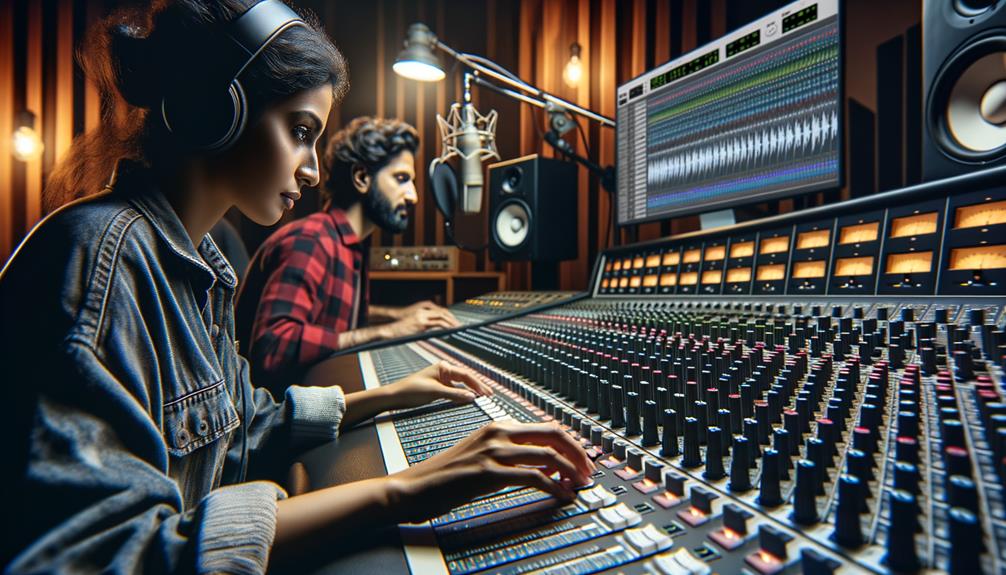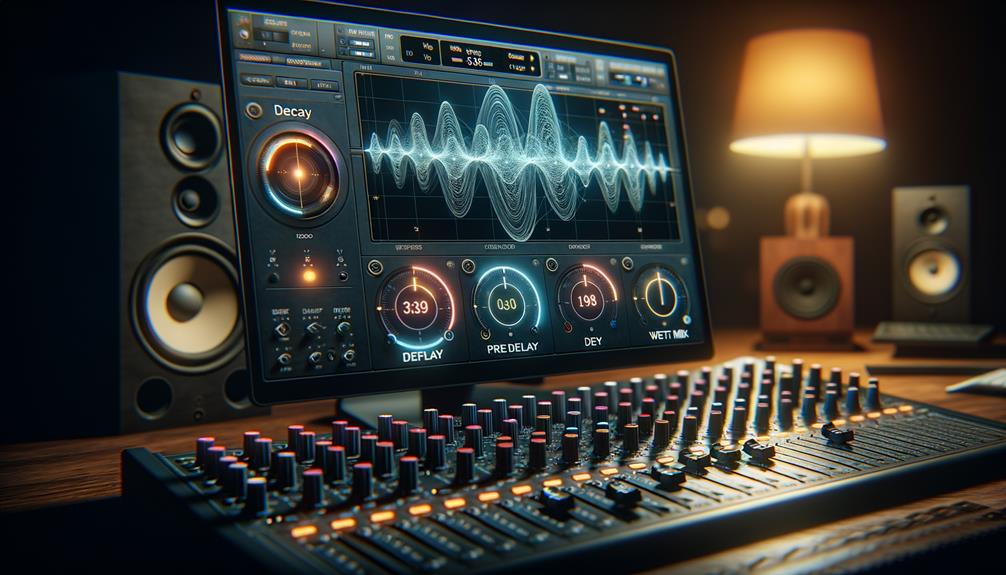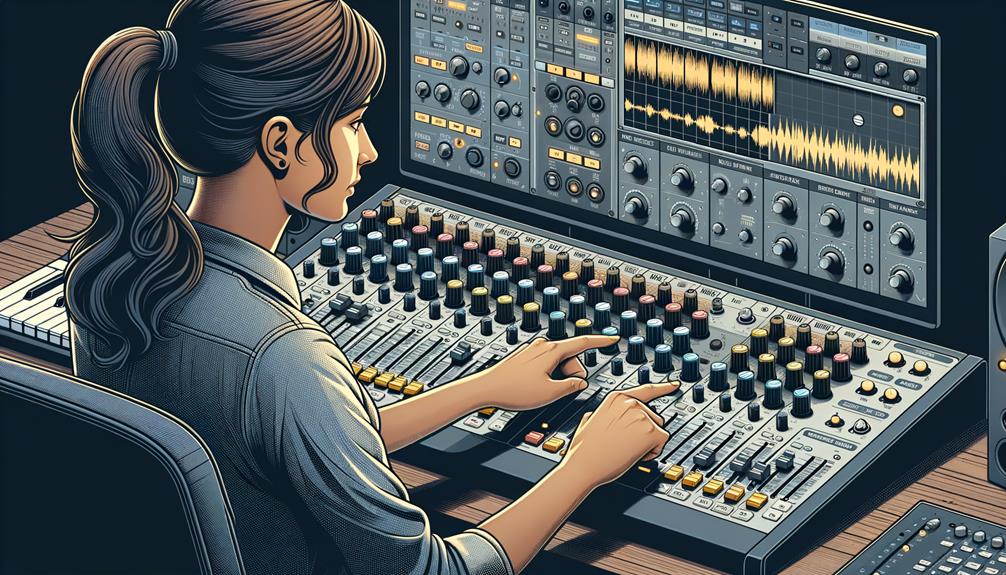No products in the cart.
If you’ve ever heard the saying ‘less is more,’ then you know the importance of using reverb on vocals sparingly.
But finding the right balance and knowing how to effectively apply reverb to vocals can be a game-changer in your mix.
From understanding the basics of reverb to choosing the right type and setting up parameters, there are several key techniques that can take your vocal sound to the next level.
So, if you’re looking to add that professional polish and depth to your vocal tracks, there are some essential tips and tricks that you won’t want to miss.
Contents
hide
Key Takeaways
- Decay time is crucial for achieving the desired vocal reverb effect.
- Plate reverb is a popular choice for vocals.
- Balancing reverb and vocals can be achieved with high and low pass filters.
- Matching the reverb to the instrumental mix creates a cohesive and harmonious sound.
Understanding the Basics of Reverb
Understanding the basics of reverb is essential for achieving a well-balanced and immersive vocal mix. When it comes to vocal reverb, one important factor to consider is the decay time. This is the duration it takes for the reverb to fade out. For vocals, a shorter decay time is often preferred to maintain clarity and prevent muddiness.
Plate reverb, such as the large plate at Abbey Road, is a popular choice for vocals due to its smooth and lush character. It can add depth and dimension to the vocals without overpowering them.
In vocal reverb, it’s crucial to strike a balance between creating a sense of space and maintaining clarity. The Abbey Road trick for vocal reverb involves using high and low pass filters to find the right balance and space without overwhelming the vocals. This technique allows the reverb to enhance the vocals without overshadowing them.
Additionally, adjusting the vocal reverb to match the instrumental’s vibe, brightness, and size can create a cohesive and immersive soundstage. By understanding the basics of reverb and its application to vocals, you can craft a compelling and innovative sonic experience.
Choosing the Right Reverb Type
When choosing the right reverb type for vocals, consider the sonic characteristics of the instrumental mix to ensure a cohesive and balanced sound. The choice of reverb type is crucial in enhancing the vocals without overshadowing or clashing with the instrumental elements.
Utilizing a reverb plugin that offers a variety of reverb types allows you to tailor the reverb effect to the specific track. Adjust the reverb parameters to fit the brightness, darkness, clarity, saturation, and size of the instrumental mix. For a darker mix, cutting high-end frequencies in the reverb can help it blend seamlessly. Conversely, creating contrast between a bright vocal reverb and a dark instrumental mix can add an interesting dynamic to the overall sound.
Experiment with different reverb types and settings to find the perfect balance between the vocal and instrumental reverbs. This process of experimentation is key to achieving a unique and innovative sound that complements the overall musical composition.
Setting Up Reverb Parameters

To achieve the desired vocal effect, experiment with different reverb settings, such as pre-delay, decay time, and diffusion.
Adjust the pre-delay to create space between the dry vocals and the reverb, enhancing the sense of depth in the mix. This technique can help prevent the reverb from clouding the initial vocal attack.
Use the decay time parameter to control the length of the reverb tail, influencing the overall spaciousness of the vocals. A longer decay time can create a more lush and atmospheric effect, while a shorter decay time can provide a tighter, more intimate sound.
Consider adjusting the diffusion setting to control the density and clarity of the reverb, affecting the smoothness and texture of the vocal effect. This parameter can be used to achieve a more natural or more processed sound, depending on the desired artistic direction.
Additionally, utilize EQ within the reverb plugin to shape the tonal characteristics of the reverb, tailoring it to complement the vocals in the mix.
These parameters provide a powerful toolkit for sculpting the perfect reverb for your vocals.
Enhancing Vocals With Reverb
After setting up reverb parameters for your vocals, you can further enhance the vocal sound by experimenting with various techniques and creative approaches to achieve unique and compelling reverb effects.
One method involves creating alternative signals for vocal reverb. By duplicating vocals, pitching them down, and adding different effects, you can achieve a distinct sound.
Another technique is the Abbey Road trick, where high and low pass filters are used to strike a balance between space and not overwhelming the vocals.
To create a wider stereo image for vocals, consider using multiple mono reverbs on separate auxiliary tracks and panning them left and right.
It’s also important to match the vocal reverb to the instrumental by adjusting the reverb to fit the mix’s brightness, darkness, clarity, saturation, and size.
Additionally, using reverse reverb as a transition effect, especially for big choruses, can be achieved by applying a long reverb plugin to reversed audio and fading it in for a smooth transition effect.
These techniques, when applied in software like Pro Tools, can greatly enhance the vocals, adding depth and character to the dry signal and tail of the reverb.
Tips for Mixing Vocals With Reverb


Consider experimenting with alternative signals for vocal reverb, such as duplicating vocals, pitching them down, and adding distortion or pitch effects to create new and interesting textures. When mixing vocals with reverb, using this technique opens up a world of creative possibilities.
Here are some tips for mixing vocals with reverb:
- Utilize Low-End Processing: Experiment with adding reverb to the lower frequencies of the vocal to enhance warmth and depth. This can be achieved by sending only the low end of the vocal to a reverb bus and blending it with the dry signal to create a rich and full sound.
- Find the Balance: Consider how much reverb is appropriate for the vocal. Too much reverb can make the vocals sound distant and muddy, while too little can make them sound dry and lacking in depth. Experiment with different reverb levels to find the sweet spot that complements the vocals without overpowering them.
- Create Unique Textures: Try applying pitch effects or distortion to the reverb signal to add character and uniqueness to the vocal sound. This can help the vocals stand out in the mix and create a captivating sonic experience.
- Experiment with Different Reverb Types: Different types of reverbs can produce distinct sonic qualities. Experiment with plate, hall, room, and spring reverbs to find the one that sounds best for the vocals in the context of the mix.
Frequently Asked Questions
Should You Use Reverb on Vocals?
Using reverb on vocals offers creative effects, enhancing artistic expression. However, be mindful of potential drawbacks, such as compromising vocal clarity. Employ mixing techniques to balance the pros and cons for optimal impact.
What Is the Best Reverb Mode for Vocals?
For vocal mixing, adjust reverb settings in studio recording. Experiment with vocal effects and mixing techniques to find the best mode. Enhance the dimension and balance of the mix while matching the instrumental vibe.
How and When to Use Reverb?
When mixing vocals, strategically use reverb techniques to create depth and ambiance. Experiment with duplicating vocals or adding distortion for unique reverb signals. Balance space with high and low pass filters, and match vocal space to the instrumental mix.
Does Reverb Make Your Voice Echo?
Reverb effect can enhance vocal presence and depth without causing an echo. Adjust reverb settings to reduce echo, balance space, and maintain vocal clarity. Experiment with different reverb types to innovate and elevate your vocal production.
Conclusion
In conclusion, mastering the art of using reverb on vocals requires an understanding of the basics, choosing the right reverb type, and setting up parameters to enhance the vocals.
It’s important to consider alternative techniques such as duplicating vocals and using multiple mono reverbs for a wider stereo image.
By matching the vocal space to the instrumental and utilizing different reverb types, achieving the perfect vocal mix is within reach.




